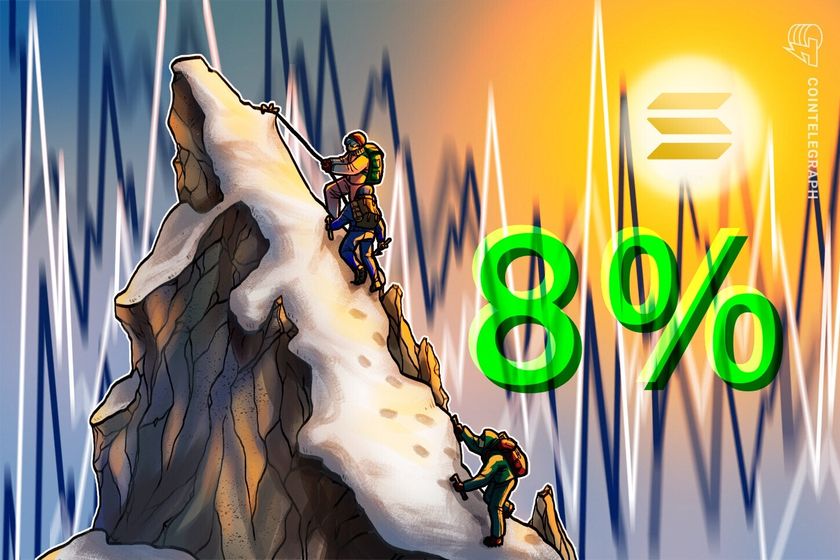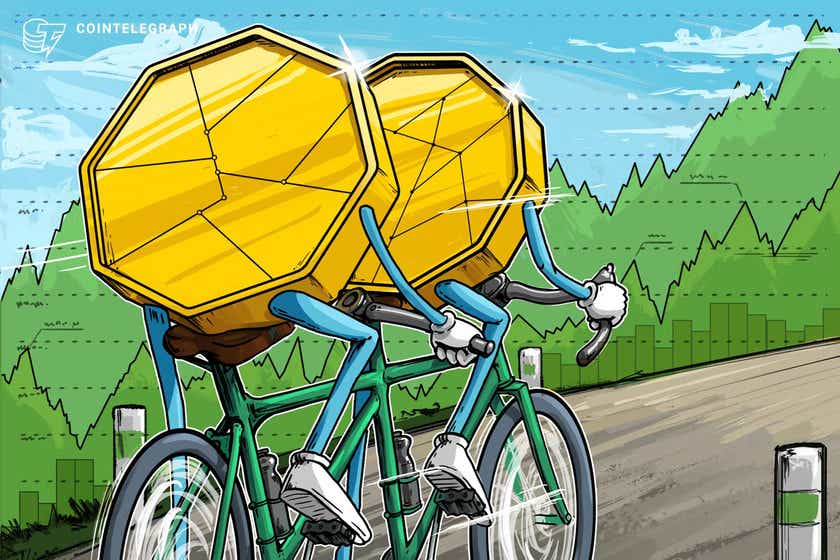Polygon supernets vs. Avalanche subnets: Key differences
What is Bitcoin? How does blockchain work? How to mine cryptocurrency? We are glad to help you answer these questions with our quick guides in Explained section.
rn”,”seo_description”:”What is Bitcoin? How does blockchain work? How to mine cryptocurrency? We are glad to help you answer these questions with our quick guides in Explained section.”},”words_count”:966,”description”:”Both Polygon supernets and Avalanche subnets are scalability solutions that help developers deploy app chains.”,”author”:{“id”:1418,”title”:”Marcel Deer”,”url”:”marcel-deer”,”twitter”:””,”google_plus”:””,”photo”:”https://s3.cointelegraph.com/storage/uploads/view/a427b150b57d0a9ad4054cf042cf01b8.jpg”,”gender”:”male”,”description”:”A qualified journalist with a background in PR and marketing, Marcel has been passionate about crypto since he first read the Cypherpunks Manifesto. As a strong believer in the power of DeFi, decentralization, and the digital economy, when he’s not writing, he’s researching the latest node projects and actively enjoying the crypto community on Twitter.”,”facebook”:””,”email”:””,”linkedin”:””,”created_at”:”2021-11-07 07:02:27″,”updated_at”:”2022-05-04 15:55:37″,”deleted_at”:null,”innovation_circle_url”:null,”avatar”:”https://images.cointelegraph.com/images/150_aHR0cHM6Ly9zMy5jb2ludGVsZWdyYXBoLmNvbS9zdG9yYWdlL3VwbG9hZHMvdmlldy9hNDI3YjE1MGI1N2QwYTlhZDQwNTRjZjA0MmNmMDFiOC5qcGc=.jpg”,”hash”:”aHR0cHM6Ly9jb2ludGVsZWdyYXBoLmNvbS9hdXRob3JzL21hcmNlbC1kZWVy”,”relativeUrl”:”https://cointelegraph.com/authors/marcel-deer”,”user_id”:1418,”language_id”:1,”name”:”Marcel Deer”,”desc”:”A qualified journalist with a background in PR and marketing, Marcel has been passionate about crypto since he first read the Cypherpunks Manifesto. As a strong believer in the power of DeFi, decentralization, and the digital economy, when he’s not writing, he’s researching the latest node projects and actively enjoying the crypto community on Twitter.”,”seo_title”:””,”seo_description”:””,”enabled”:1,”show_in_authors”:0,”show_in_experts”:0},”category_id”:65,”audio”:”https://s3.cointelegraph.com/audio/104756.7db51a9a-b30f-4797-82a9-8732b7ba3a00.mp3″,”tags”:[{“name”:”Blockchain”,”uri”:”/tags/blockchain”,”super”:1,”page_title”:”Blockchain News”},{“name”:”Polygon”,”uri”:”/tags/polygon”,”super”:0,”page_title”:””},{“name”:”Avalanche”,”uri”:”/tags/avalanche”,”super”:0,”page_title”:””}],”tag_title”:”Blockchain”,”date”:”34 MINUTES AGO”,”badge”:{“title”:”Explained”,”label”:”default”},”qty”:11,”stats_pixel”:”“,”stats_pixel_url”:”https://zoa.cointelegraph.com/pixel?postId=104756®ionId=1″,”shares”:2,”infographic”:false,”sponsored”:false,”explained”:true,”press_release”:false,”show_referral”:false,”social_description”:”Confused about scalability solutions for app chains? This article breaks down the key differences between Polygon supernets and Avalanche subnets.”,”social_translators”:{“clipboard_popup_label”:”Link copied”,”socialWechatFooterError”:”WeChat error”,”socialWechatFooterText”:”WeChat share”,”socialWechatHeaderText”:”WeChat share”},”social_shares”:{“post_id”:104756,”post_url”:”https://cointelegraph.com/explained/polygon-supernets-vs-avalanche-subnets-key-differences”,”post_titles”:{“normal”:”Polygon supernets vs. Avalanche subnets: Key differences”,”twitter”:”Polygon supernets vs. Avalanche subnets: Key differences”},”post_text”:{“normal”:”Polygon supernets vs. Avalanche subnets: Key differences”,”twitter”:”Polygon supernets vs. Avalanche subnets: Key differences https://cointelegraph.com/explained/polygon-supernets-vs-avalanche-subnets-key-differences via @cointelegraph”},”accounts”:{“twitter”:”@cointelegraph”}},”socials”:{“facebook”:{“url”:”https://www.facebook.com/sharer/sharer.php?u=https%3A%2F%2Fcointelegraph.com%2Fexplained%2Fpolygon-supernets-vs-avalanche-subnets-key-differences”,”count”:null,”short”:”fb”,”fa”:”facebook”},”twitter”:{“url”:”https://twitter.com/intent/tweet?text=Polygon+supernets+vs.+Avalanche+subnets%3A+Key+differences https%3A%2F%2Fcointelegraph.com%2Fexplained%2Fpolygon-supernets-vs-avalanche-subnets-key-differences via @cointelegraph”,”count”:null,”short”:”tw”,”fa”:”twitter”},”telegram”:{“url”:”https://telegram.me/share/url?url=https%3A%2F%2Fcointelegraph.com%2Fexplained%2Fpolygon-supernets-vs-avalanche-subnets-key-differences &text=Polygon+supernets+vs.+Avalanche+subnets%3A+Key+differences”,”count”:null,”short”:”tg”,”fa”:”paper-plane”},”whatsapp”:{“url”:”https://api.whatsapp.com/send?text=Polygon+supernets+vs.+Avalanche+subnets%3A+Key+differences&href=https%3A%2F%2Fcointelegraph.com%2Fexplained%2Fpolygon-supernets-vs-avalanche-subnets-key-differences”,”count”:null,”short”:”wu”,”fa”:”whatsapp”},”gplus”:{“url”:”https://plus.google.com/share?url=https%3A%2F%2Fcointelegraph.com%2Fexplained%2Fpolygon-supernets-vs-avalanche-subnets-key-differences”,”count”:null,”short”:”gplus”,”fa”:”google-plus”},”reddit”:{“url”:”https://www.reddit.com/submit?url=https%3A%2F%2Fcointelegraph.com%2Fexplained%2Fpolygon-supernets-vs-avalanche-subnets-key-differences&title=Polygon+supernets+vs.+Avalanche+subnets%3A+Key+differences”,”count”:null,”short”:”reddit”,”fa”:”reddit-alien”},”linkedin”:{“url”:”https://www.linkedin.com/shareArticle?mini=true&url=https%3A%2F%2Fcointelegraph.com%2Fexplained%2Fpolygon-supernets-vs-avalanche-subnets-key-differences&title=Polygon+supernets+vs.+Avalanche+subnets%3A+Key+differences”,”count”:null,”short”:”li”,”fa”:”linkedin”}},”hide_disclaimer”:false,”elink”:”https://cointelegraph.com”,”etitle”:”Cointelegraph”,”elogo_x2″:”https://images.cointelegraph.com/images/528_aHR0cHM6Ly9zMy5jb2ludGVsZWdyYXBoLmNvbS9zdG9yYWdlL3VwbG9hZHMvdmlldy9hYjAzYTJhMmNlOWEyMWRjMWYwOTYxZDkxNzMxYzhiYS5wbmc=.png”,”elogo_x1″:”https://images.cointelegraph.com/images/260_aHR0cHM6Ly9zMy5jb2ludGVsZWdyYXBoLmNvbS9zdG9yYWdlL3VwbG9hZHMvdmlldy9hYjAzYTJhMmNlOWEyMWRjMWYwOTYxZDkxNzMxYzhiYS5wbmc=.png”,”elogo_svg”:false,”content”:[{“id”:4015,”post_id”:104756,”title”:”What is a Polygon supernet?”,”content”:”
Designed to be a scalability solution, Supernet is the Polygon network’s blockchain development platform that aims to help developers create their own blockchain protocols in a cost-efficient way.
nn
Developers building on the Polygon network can access a wide range of validators and tools for effortless integration and third-party services to assist with implementation, design and management.
nn
Technically, supernets work on problem-solving for Polygon’s development framework, Polygon Edge. Polygon Edge helps build Ethereum-compatible blockchains while keeping them secure, decentralized and efficient.
nn
The big picture concept of supernets is that they are collections of interconnected networks that promote collaborative work while serving as a secure data-sharing hub. They can hold and organize large quantities of data and facilitate communication among users.
nn
The benefits of using Polygon supernets include interoperability, specificity, enhanced scalability, security and better decentralization. Supernets also address Polygon Edge’s technical challenges really well, especially regarding chain configurations and bootstrapping decentralized validator sets.
nn
Related: What is a supernet, and how does it work?
nnnn”,”created_at”:”2023-03-17 09:40:11″,”updated_at”:”2023-03-17 09:44:17″,”sort”:1,”translations”:{“id”:4008,”explained_post_id”:4015,”title_en”:”What is a Polygon supernet?”,”content_en”:”
Designed to be a scalability solution, Supernet is the Polygon network’s blockchain development platform that aims to help developers create their own blockchain protocols in a cost-efficient way.
nn
Developers building on the Polygon network can access a wide range of validators and tools for effortless integration and third-party services to assist with implementation, design and management.
nn
Technically, supernets work on problem-solving for Polygon’s development framework, Polygon Edge. Polygon Edge helps build Ethereum-compatible blockchains while keeping them secure, decentralized and efficient.
nn
The big picture concept of supernets is that they are collections of interconnected networks that promote collaborative work while serving as a secure data-sharing hub. They can hold and organize large quantities of data and facilitate communication among users.
nn
The benefits of using Polygon supernets include interoperability, specificity, enhanced scalability, security and better decentralization. Supernets also address Polygon Edge’s technical challenges really well, especially regarding chain configurations and bootstrapping decentralized validator sets.
nn
Related: What is a supernet, and how does it work?
nnnn”,”title_es”:””,”content_es”:”nn”,”title_cn”:””,”content_cn”:”nn”,”title_de”:””,”content_de”:”nn”,”title_fr”:””,”content_fr”:”nn”,”title_it”:””,”content_it”:”nn”,”title_ar”:””,”content_ar”:”nn”,”title_br”:””,”content_br”:”nn”,”title_jp”:””,”content_jp”:”nn”,”created_at”:”2023-03-17 09:40:11″,”updated_at”:”2023-03-17 09:44:17″,”title_kr”:””,”content_kr”:”nn”,”title_tr”:””,”content_tr”:”nn”}},{“id”:4016,”post_id”:104756,”title”:”How do Polygon’s supernets work?”,”content”:”
Supernets are essentially a tool that helps developers understand complex data structures with relationships that would otherwise be difficult to pinpoint.
nn
By leveraging their own blockchain network and a global pool of validators, Polygon’s supernet makes it possible for developers to create their own blockchain networks within the same framework as Ethereum but with a much lower development cost.
nn
Supernet allows developers to bring their projects online with three speedy deployment modes.
nn
- nt
- Supernet sovereign chain: This chain is managed by a single validator, enabling significant savings on maintenance costs.
- Supernet shared security chain: This chain is validated by expert validators with stakes of 20,000 Polygon (MATIC) tokens or more.
- Layer-2 chain: This chain uses zero-knowledge rollups to scale supernets and is still under development.
nt
nt
n
nn
As mentioned, supernets are built on Polygon Edge’s stack. They can be called an ecosystem, or blockchain system, as supernets are a set of modules that work and integrate seamlessly as new functions are added.
nn
With the help of supernets, developers can create a distributed blockchain network designed for a specific use case. Supernets also boast higher scalability, speed, consistent throughput and broad customization. Notably, they also allow Web3 application integration into dedicated networks, allowing maximum optimization.
nnnn”,”created_at”:”2023-03-17 09:40:32″,”updated_at”:”2023-03-17 09:44:16″,”sort”:2,”translations”:{“id”:4009,”explained_post_id”:4016,”title_en”:”How do Polygon’s supernets work?”,”content_en”:”
Supernets are essentially a tool that helps developers understand complex data structures with relationships that would otherwise be difficult to pinpoint.
nn
By leveraging their own blockchain network and a global pool of validators, Polygon’s supernet makes it possible for developers to create their own blockchain networks within the same framework as Ethereum but with a much lower development cost.
nn
Supernet allows developers to bring their projects online with three speedy deployment modes.
nn
- nt
- Supernet sovereign chain: This chain is managed by a single validator, enabling significant savings on maintenance costs.
- Supernet shared security chain: This chain is validated by expert validators with stakes of 20,000 Polygon (MATIC) tokens or more.
- Layer-2 chain: This chain uses zero-knowledge rollups to scale supernets and is still under development.
nt
nt
n
nn
As mentioned, supernets are built on Polygon Edge’s stack. They can be called an ecosystem, or blockchain system, as supernets are a set of modules that work and integrate seamlessly as new functions are added.
nn
With the help of supernets, developers can create a distributed blockchain network designed for a specific use case. Supernets also boast higher scalability, speed, consistent throughput and broad customization. Notably, they also allow Web3 application integration into dedicated networks, allowing maximum optimization.
nnnn”,”title_es”:””,”content_es”:”nn”,”title_cn”:””,”content_cn”:”nn”,”title_de”:””,”content_de”:”nn”,”title_fr”:””,”content_fr”:”nn”,”title_it”:””,”content_it”:”nn”,”title_ar”:””,”content_ar”:”nn”,”title_br”:””,”content_br”:”nn”,”title_jp”:””,”content_jp”:”nn”,”created_at”:”2023-03-17 09:40:32″,”updated_at”:”2023-03-17 09:44:16″,”title_kr”:””,”content_kr”:”nn”,”title_tr”:””,”content_tr”:”nn”}},{“id”:4017,”post_id”:104756,”title”:”What are the key features of Polygon supernets?”,”content”:”
Supernets have an advanced technical architecture powered by Polygon Edge, trustless operation via Merkle trees, Ethereum Virtual Machine (EVM) compatibility and custom token support.
nn
Supernet architecture is closely tied to that of Polygon Edge. The six modules in Polygon Edge’s architecture that are relevant to supernets include the following:
nn
- nt
- TX Pool: Acting as a repository for pending transactions, this module is the key to Polygon Edge’s event-driven architecture. Transactions can be added easily from multiple sources, and it seamlessly links up with other modules of the platform.
- Blockchain: This refers to the state database, and it holds information on accounts, smart contract code, world state and more.
- JSON-RPC: The supernet’s API layer complies with Ethereum client standards, enabling tools such as MetaMask, Web3.js, Ethers.js, Remix and Hardhat to run seamlessly on its network.
- Consensus: Supernet uses proof-of-authority and proof-of-stake consensus algorithms.
- Libp2p: This is supernet’s updated peer-to-peer networking stack that facilitates block syncing, consensus messages, transaction pool gossiping and SAM pool gossiping.
- gRPC: With its powerful communication protocol, privileged operator commands on a supernet can only be locally executed on validator nodes. Validated operators can perform online backups, obtain information from validator systems, and query and clear data stored in the transaction pool.
nt
nt
nt
nt
nt
n
nn
Supernets also operate trustlessly, meaning that each node validates every transaction independently by executing the smart contract. For the blockchain ledger to function properly, all nodes must hold an identical copy of it, consisting of a Merkle tree of blocks and extensive lists of transactions.
nn
An effort by malicious actors attempting to alter the ledger will be swiftly identified due to discrepancies in hash values from the different states incompatible with those within the Merkle tree.
nn
Supernets also have built-in EVM support, meaning that developers can write and deploy smart contracts using EVM bytecode, which is compiled from high-level languages, such as Solidity.
nn
Developers with Ethereum building experience can easily transfer their Solidity contracts to supernets without any modifications thanks to the suite of tools available, including Truffle, MetaMask, Remix and block explorers. This allows for a seamless transition from one platform to another.
nn
Lastly, supernets allow developers to create custom tokens consistent with universally recognized token interfaces, such as ERC-20. This is in line with Polygon’s goal of promoting interoperability via supernets.
nnnn”,”created_at”:”2023-03-17 09:40:54″,”updated_at”:”2023-03-17 09:44:16″,”sort”:3,”translations”:{“id”:4010,”explained_post_id”:4017,”title_en”:”What are the key features of Polygon supernets?”,”content_en”:”
Supernets have an advanced technical architecture powered by Polygon Edge, trustless operation via Merkle trees, Ethereum Virtual Machine (EVM) compatibility and custom token support.
nn
Supernet architecture is closely tied to that of Polygon Edge. The six modules in Polygon Edge’s architecture that are relevant to supernets include the following:
nn
- nt
- TX Pool: Acting as a repository for pending transactions, this module is the key to Polygon Edge’s event-driven architecture. Transactions can be added easily from multiple sources, and it seamlessly links up with other modules of the platform.
- Blockchain: This refers to the state database, and it holds information on accounts, smart contract code, world state and more.
- JSON-RPC: The supernet’s API layer complies with Ethereum client standards, enabling tools such as MetaMask, Web3.js, Ethers.js, Remix and Hardhat to run seamlessly on its network.
- Consensus: Supernet uses proof-of-authority and proof-of-stake consensus algorithms.
- Libp2p: This is supernet’s updated peer-to-peer networking stack that facilitates block syncing, consensus messages, transaction pool gossiping and SAM pool gossiping.
- gRPC: With its powerful communication protocol, privileged operator commands on a supernet can only be locally executed on validator nodes. Validated operators can perform online backups, obtain information from validator systems, and query and clear data stored in the transaction pool.
nt
nt
nt
nt
nt
n
nn
Supernets also operate trustlessly, meaning that each node validates every transaction independently by executing the smart contract. For the blockchain ledger to function properly, all nodes must hold an identical copy of it, consisting of a Merkle tree of blocks and extensive lists of transactions.
nn
An effort by malicious actors attempting to alter the ledger will be swiftly identified due to discrepancies in hash values from the different states incompatible with those within the Merkle tree.
nn
Supernets also have built-in EVM support, meaning that developers can write and deploy smart contracts using EVM bytecode, which is compiled from high-level languages, such as Solidity.
nn
Developers with Ethereum building experience can easily transfer their Solidity contracts to supernets without any modifications thanks to the suite of tools available, including Truffle, MetaMask, Remix and block explorers. This allows for a seamless transition from one platform to another.
nn
Lastly, supernets allow developers to create custom tokens consistent with universally recognized token interfaces, such as ERC-20. This is in line with Polygon’s goal of promoting interoperability via supernets.
nnnn”,”title_es”:””,”content_es”:”nn”,”title_cn”:””,”content_cn”:”nn”,”title_de”:””,”content_de”:”nn”,”title_fr”:””,”content_fr”:”nn”,”title_it”:””,”content_it”:”nn”,”title_ar”:””,”content_ar”:”nn”,”title_br”:””,”content_br”:”nn”,”title_jp”:””,”content_jp”:”nn”,”created_at”:”2023-03-17 09:40:54″,”updated_at”:”2023-03-17 09:44:16″,”title_kr”:””,”content_kr”:”nn”,”title_tr”:””,”content_tr”:”nn”}},{“id”:4018,”post_id”:104756,”title”:”What is Avalanche’s subnet?”,”content”:”
Avalanche defines subnets as validators functioning together to reach a consensus on the state of blockchains.
nn
Subnets facilitate app chains by supplying validators that various blockchains can share. Subnets within the Avalanche network facilitate the creation of customized blockchains, allowing developers and tech-minded businesses to build their own blockchains without needing a token.
nn
The network’s mainnet comprises three chains:
nn
- nt
- X-Chain: A payment chain for minting nonfungible tokens (NFTs).
- C-Chain: An Ethereum Virtual Machine smart contract platform for creating decentralized applications.
- P-Chain: Responsible for coordinating validators on Avalanche as well as creating and managing subnets.
nt
nt
n
nn
The Avalanche network is sustained by the primary subnet, which contains all its validators. It’s their duty to validate the primary network and X, P and C chains, facilitating the connectivity between subnets and allowing validators to validate additional blockchains built on the network.
nn

nnnn”,”created_at”:”2023-03-17 09:42:12″,”updated_at”:”2023-03-17 09:44:16″,”sort”:4,”translations”:{“id”:4011,”explained_post_id”:4018,”title_en”:”What is Avalanche’s subnet?”,”content_en”:”
Avalanche defines subnets as validators functioning together to reach a consensus on the state of blockchains.
nn
Subnets facilitate app chains by supplying validators that various blockchains can share. Subnets within the Avalanche network facilitate the creation of customized blockchains, allowing developers and tech-minded businesses to build their own blockchains without needing a token.
nn
The network’s mainnet comprises three chains:
nn
- nt
- X-Chain: A payment chain for minting nonfungible tokens (NFTs).
- C-Chain: An Ethereum Virtual Machine smart contract platform for creating decentralized applications.
- P-Chain: Responsible for coordinating validators on Avalanche as well as creating and managing subnets.
nt
nt
n
nn
The Avalanche network is sustained by the primary subnet, which contains all its validators. It’s their duty to validate the primary network and X, P and C chains, facilitating the connectivity between subnets and allowing validators to validate additional blockchains built on the network.
nn

nnnn”,”title_es”:””,”content_es”:”nn”,”title_cn”:””,”content_cn”:”nn”,”title_de”:””,”content_de”:”nn”,”title_fr”:””,”content_fr”:”nn”,”title_it”:””,”content_it”:”nn”,”title_ar”:””,”content_ar”:”nn”,”title_br”:””,”content_br”:”nn”,”title_jp”:””,”content_jp”:”nn”,”created_at”:”2023-03-17 09:42:12″,”updated_at”:”2023-03-17 09:44:16″,”title_kr”:””,”content_kr”:”nn”,”title_tr”:””,”content_tr”:”nn”}},{“id”:4019,”post_id”:104756,”title”:”How do Avalanche subnets work?”,”content”:”
Avalanche subnets act in unison to keep the state of blockchains up-to-date. Essentially, these subnets provide the foundation for app-chain networks by providing decentralized validator services across different chains.
nn
A chain can be validated by only one specific subnet, but one subnet can validate multiple chains. Every subnet has its governance and requirements, such as licenses, country location, and Know Your Customer and Anti-Money Laundering checks. To join the primary network, validators must stake 2,000 Avalanche (AVAX) tokens before validating built-in chains on the network.
nn
Related: What is KYC, and why do crypto exchanges require it?
nn
Subnets are highly configurable but do not require complex design choices, allowing developers to create private blockchains that are reliable and scalable. Avalanche’s subnet system thus helps developers build decentralized apps (DApps) quickly while maintaining the highest security standards.
nnnn”,”created_at”:”2023-03-17 09:42:33″,”updated_at”:”2023-03-17 09:44:16″,”sort”:5,”translations”:{“id”:4012,”explained_post_id”:4019,”title_en”:”How do Avalanche subnets work?”,”content_en”:”
Avalanche subnets act in unison to keep the state of blockchains up-to-date. Essentially, these subnets provide the foundation for app-chain networks by providing decentralized validator services across different chains.
nn
A chain can be validated by only one specific subnet, but one subnet can validate multiple chains. Every subnet has its governance and requirements, such as licenses, country location, and Know Your Customer and Anti-Money Laundering checks. To join the primary network, validators must stake 2,000 Avalanche (AVAX) tokens before validating built-in chains on the network.
nn
Related: What is KYC, and why do crypto exchanges require it?
nn
Subnets are highly configurable but do not require complex design choices, allowing developers to create private blockchains that are reliable and scalable. Avalanche’s subnet system thus helps developers build decentralized apps (DApps) quickly while maintaining the highest security standards.
nnnn”,”title_es”:””,”content_es”:”nn”,”title_cn”:””,”content_cn”:”nn”,”title_de”:””,”content_de”:”nn”,”title_fr”:””,”content_fr”:”nn”,”title_it”:””,”content_it”:”nn”,”title_ar”:””,”content_ar”:”nn”,”title_br”:””,”content_br”:”nn”,”title_jp”:””,”content_jp”:”nn”,”created_at”:”2023-03-17 09:42:33″,”updated_at”:”2023-03-17 09:44:16″,”title_kr”:””,”content_kr”:”nn”,”title_tr”:””,”content_tr”:”nn”}},{“id”:4020,”post_id”:104756,”title”:”What are the key features of Avalanche subnets?”,”content”:”
Subnets offer many useful features, such as the ability to create private blockchains, separation of concerns and the requirement of validators to stake AVAX tokens before validating built-in chains.
nn
Subnets support private blockchain creation, allowing developers to create subnets wherein only predefined validators can join. In such a scenario, these validators would be able to create a private subnet and view the contents of the blockchains they have access to. This is an ideal framework for organizations that need to keep their data private.
nn
Subnets also support a separation of concerns, which, in the context of blockchain technology, refers to the ability of validators to only concern themselves with blockchains that they are interested in. This reduces the burden on validators, unlike models followed by heterogenous networks that require validators to validate even the blockchains they are not interested in.
nn
Subnets also allow for application-specific requirements, letting developers define validator requirements, such as higher amounts of CPU power or RAM and other hardware requirements. This will ensure that the application works at peak efficiency and does not suffer from low performance caused by slow validators.
nnnn”,”created_at”:”2023-03-17 09:42:52″,”updated_at”:”2023-03-17 09:44:16″,”sort”:6,”translations”:{“id”:4013,”explained_post_id”:4020,”title_en”:”What are the key features of Avalanche subnets?”,”content_en”:”
Subnets offer many useful features, such as the ability to create private blockchains, separation of concerns and the requirement of validators to stake AVAX tokens before validating built-in chains.
nn
Subnets support private blockchain creation, allowing developers to create subnets wherein only predefined validators can join. In such a scenario, these validators would be able to create a private subnet and view the contents of the blockchains they have access to. This is an ideal framework for organizations that need to keep their data private.
nn
Subnets also support a separation of concerns, which, in the context of blockchain technology, refers to the ability of validators to only concern themselves with blockchains that they are interested in. This reduces the burden on validators, unlike models followed by heterogenous networks that require validators to validate even the blockchains they are not interested in.
nn
Subnets also allow for application-specific requirements, letting developers define validator requirements, such as higher amounts of CPU power or RAM and other hardware requirements. This will ensure that the application works at peak efficiency and does not suffer from low performance caused by slow validators.
nnnn”,”title_es”:””,”content_es”:”nn”,”title_cn”:””,”content_cn”:”nn”,”title_de”:””,”content_de”:”nn”,”title_fr”:””,”content_fr”:”nn”,”title_it”:””,”content_it”:”nn”,”title_ar”:””,”content_ar”:”nn”,”title_br”:””,”content_br”:”nn”,”title_jp”:””,”content_jp”:”nn”,”created_at”:”2023-03-17 09:42:52″,”updated_at”:”2023-03-17 09:44:16″,”title_kr”:””,”content_kr”:”nn”,”title_tr”:””,”content_tr”:”nn”}},{“id”:4021,”post_id”:104756,”title”:”What is the difference between Polygon supernets and Avalanche subnets?”,”content”:”
Both subnets and supernets are scalability solutions that allow developers to deploy or develop app chains rapidly. However, they differ in several ways, such as consensus mechanisms, transactions per second, validator numbers and staking requirements.
nn
Avalanche uses the Snowman proof-of-stake consensus protocol, which provides probabilistic consensus to enable scalability and infinite decentralization.
nn
Polygon, on the other hand, uses an Istanbul Byzantine fault tolerance (IBFT) consensus protocol to achieve guaranteed consensus, ultimately disfavoring decentralization and sacrificing permissionless participation.
nn

nn
As the adoption of blockchain technology continues to grow, these technologies are likely to become more widespread and essential for building DApps.
nnnn”,”created_at”:”2023-03-17 09:43:49″,”updated_at”:”2023-03-17 09:44:16″,”sort”:7,”translations”:{“id”:4014,”explained_post_id”:4021,”title_en”:”What is the difference between Polygon supernets and Avalanche subnets?”,”content_en”:”
Both subnets and supernets are scalability solutions that allow developers to deploy or develop app chains rapidly. However, they differ in several ways, such as consensus mechanisms, transactions per second, validator numbers and staking requirements.
nn
Avalanche uses the Snowman proof-of-stake consensus protocol, which provides probabilistic consensus to enable scalability and infinite decentralization.
nn
Polygon, on the other hand, uses an Istanbul Byzantine fault tolerance (IBFT) consensus protocol to achieve guaranteed consensus, ultimately disfavoring decentralization and sacrificing permissionless participation.
nn

nn
As the adoption of blockchain technology continues to grow, these technologies are likely to become more widespread and essential for building DApps.
nnnn”,”title_es”:””,”content_es”:”nn”,”title_cn”:””,”content_cn”:”nn”,”title_de”:””,”content_de”:”nn”,”title_fr”:””,”content_fr”:”nn”,”title_it”:””,”content_it”:”nn”,”title_ar”:””,”content_ar”:”nn”,”title_br”:””,”content_br”:”nn”,”title_jp”:””,”content_jp”:”nn”,”created_at”:”2023-03-17 09:43:49″,”updated_at”:”2023-03-17 09:44:16″,”title_kr”:””,”content_kr”:”nn”,”title_tr”:””,”content_tr”:”nn”}}],”is_partner_material”:false,”commentsSection”:{“schemaEntityUrl”:”//cointelegraph.com/explained/polygon-supernets-vs-avalanche-subnets-key-differences”,”list”:[],”amount”:0,”i18n”:{“addComment”:”Add a comment…”,”amountOnePostfix”:”Comment”,”amountPostfix”:”Comments”,”cancel”:”Cancel”,”delete”:”Delete”,”edit”:”Edit”,”errorBig”:”Comment text cannot be longer than 2000 characters”,”errorDuplicate”:”Duplicate comment”,”errorSmall”:”Comment text must be at least 2 characters long”,”hideButton”:”Hide comments”,”noComments”:” “,”commentOnModeration”:”Comment on moderation”,”postComment”:”Post”,”reply”:”Reply”,”showAllComments”:”Show All Comments”,”showButtonPostfix”:”comments”,”showButtonPrefix”:”Show”,”signIn”:”Sign in”,”update”:”Update comment”,”commentWasDeleted”:”This comment has been deleted”}},”related”:[{“id”:85203,”retina”:”https://images.cointelegraph.com/images/1480_aHR0cHM6Ly9zMy5jb2ludGVsZWdyYXBoLmNvbS9zdG9yYWdlL3VwbG9hZHMvdmlldy9lYjk1OWJlZjM0ODkwNzU3NjA1YjNiOWM3NTMyMDk2Ni5qcGc=.jpg”,”img”:”https://images.cointelegraph.com/images/740_aHR0cHM6Ly9zMy5jb2ludGVsZWdyYXBoLmNvbS9zdG9yYWdlL3VwbG9hZHMvdmlldy9lYjk1OWJlZjM0ODkwNzU3NjA1YjNiOWM3NTMyMDk2Ni5qcGc=.jpg”,”thumb”:”https://images.cointelegraph.com/images/370_aHR0cHM6Ly9zMy5jb2ludGVsZWdyYXBoLmNvbS9zdG9yYWdlL3VwbG9hZHMvdmlldy9lYjk1OWJlZjM0ODkwNzU3NjA1YjNiOWM3NTMyMDk2Ni5qcGc=.jpg”,”thumb370″:”https://images.cointelegraph.com/images/370_aHR0cHM6Ly9zMy5jb2ludGVsZWdyYXBoLmNvbS9zdG9yYWdlL3VwbG9hZHMvdmlldy9lYjk1OWJlZjM0ODkwNzU3NjA1YjNiOWM3NTMyMDk2Ni5qcGc=.jpg”,”amp_thumb”:”https://images.cointelegraph.com/images/150_aHR0cHM6Ly9zMy5jb2ludGVsZWdyYXBoLmNvbS9zdG9yYWdlL3VwbG9hZHMvdmlldy9lYjk1OWJlZjM0ODkwNzU3NjA1YjNiOWM3NTMyMDk2Ni5qcGc=.jpg”,”thumb150″:”https://images.cointelegraph.com/images/150_aHR0cHM6Ly9zMy5jb2ludGVsZWdyYXBoLmNvbS9zdG9yYWdlL3VwbG9hZHMvdmlldy9lYjk1OWJlZjM0ODkwNzU3NjA1YjNiOWM3NTMyMDk2Ni5qcGc=.jpg”,”url”:”https://cointelegraph.com/explained/what-is-impermanent-loss-and-how-to-avoid-it”,”title”:”What is impermanent loss and how to avoid it?”,”lead”:”Read this guide to understand the risk, known as impermanent loss (IL), that liquidity providers take in exchange for fees earned in liquidity pools.”,”leadfull”:””,”category_id”:65,”category_url”:”https://cointelegraph.com/explained”,”category_title”:”Explained”,”author_url”:”https://cointelegraph.com/authors/onkar-singh”,”author_hash”:”aHR0cHM6Ly9jb2ludGVsZWdyYXBoLmNvbS9hdXRob3JzL29ua2FyLXNpbmdo”,”author_title”:”Onkar Singh”,”author_img”:”https://cointelegraph.com/assets/img/icons/author_male.jpg”,”date”:”APR 25, 2022″,”flash_date”:”APR 25, 2022″,”sponsored”:false,”press_release”:false,”sponsored_label”:”Sponsored”,”explained”:true,”badge”:{“title”:”Explained”,”label”:”default”},”published”:{“date”:”2022-04-25 00:00:00.000000″,”timezone_type”:3,”timezone”:”Europe/London”},”stat_uniqs”:56,”rss_date”:”Mon, 25 Apr 2022 00:00:00 +0100″,”publishedW3″:”2022-04-25T00:00:00+01:00″,”show_referral”:false,”isMagazine”:false},{“id”:103259,”retina”:”https://images.cointelegraph.com/images/1480_aHR0cHM6Ly9zMy5jb2ludGVsZWdyYXBoLmNvbS91cGxvYWRzLzIwMjMtMDIvMGI3MGM0ZjctNWNkOS00ZGFjLWJlZmQtZmM4MjY2ODBlOGRjLmpwZw==.jpg”,”img”:”https://images.cointelegraph.com/images/740_aHR0cHM6Ly9zMy5jb2ludGVsZWdyYXBoLmNvbS91cGxvYWRzLzIwMjMtMDIvMGI3MGM0ZjctNWNkOS00ZGFjLWJlZmQtZmM4MjY2ODBlOGRjLmpwZw==.jpg”,”thumb”:”https://images.cointelegraph.com/images/370_aHR0cHM6Ly9zMy5jb2ludGVsZWdyYXBoLmNvbS91cGxvYWRzLzIwMjMtMDIvMGI3MGM0ZjctNWNkOS00ZGFjLWJlZmQtZmM4MjY2ODBlOGRjLmpwZw==.jpg”,”thumb370″:”https://images.cointelegraph.com/images/370_aHR0cHM6Ly9zMy5jb2ludGVsZWdyYXBoLmNvbS91cGxvYWRzLzIwMjMtMDIvMGI3MGM0ZjctNWNkOS00ZGFjLWJlZmQtZmM4MjY2ODBlOGRjLmpwZw==.jpg”,”amp_thumb”:”https://images.cointelegraph.com/images/150_aHR0cHM6Ly9zMy5jb2ludGVsZWdyYXBoLmNvbS91cGxvYWRzLzIwMjMtMDIvMGI3MGM0ZjctNWNkOS00ZGFjLWJlZmQtZmM4MjY2ODBlOGRjLmpwZw==.jpg”,”thumb150″:”https://images.cointelegraph.com/images/150_aHR0cHM6Ly9zMy5jb2ludGVsZWdyYXBoLmNvbS91cGxvYWRzLzIwMjMtMDIvMGI3MGM0ZjctNWNkOS00ZGFjLWJlZmQtZmM4MjY2ODBlOGRjLmpwZw==.jpg”,”url”:”https://cointelegraph.com/news/polygon-blockchain-reportedly-suffers-network-outage”,”title”:”Polygonscan went down, causing unwarranted concern of blockchain outage”,”lead”:”Data from PolygonScan showed that the blockchain had not produced any new blocks or processed transactions for some time, leading some to believe it was sufferi…”,”leadfull”:””,”category_id”:2,”category_url”:”https://cointelegraph.com/category/latest-news”,”category_title”:”Latest News”,”author_url”:”https://cointelegraph.com/authors/luke-huigsloot”,”author_hash”:”aHR0cHM6Ly9jb2ludGVsZWdyYXBoLmNvbS9hdXRob3JzL2x1a2UtaHVpZ3Nsb290″,”author_title”:” Luke Huigsloot “,”author_img”:”https://images.cointelegraph.com/images/32_aHR0cHM6Ly9zMy5jb2ludGVsZWdyYXBoLmNvbS9zdG9yYWdlL3VwbG9hZHMvdmlldy85MjQ0YzIxNThlNjZkMWY4OTI1N2I3ZjgzZDI5ODE0Yy5qcGc=.jpg”,”date”:”FEB 22, 2023″,”flash_date”:”FEB 22, 2023″,”sponsored”:false,”press_release”:false,”sponsored_label”:”Sponsored”,”explained”:false,”badge”:{“title”:”News”,”label”:”default”},”published”:{“date”:”2023-02-22 22:29:42.000000″,”timezone_type”:3,”timezone”:”Europe/London”},”stat_uniqs”:8442,”rss_date”:”Wed, 22 Feb 2023 22:29:42 +0000″,”publishedW3″:”2023-02-22T22:29:42+00:00″,”show_referral”:true,”isMagazine”:false},{“id”:103730,”retina”:”https://images.cointelegraph.com/images/1480_aHR0cHM6Ly9zMy5jb2ludGVsZWdyYXBoLmNvbS9zdG9yYWdlL3VwbG9hZHMvdmlldy84ZDlmZWI4ZWQ2OTYwNmYzYzU0Nzk5NjA2NzZmMTNkNy5qcGVn.jpeg”,”img”:”https://images.cointelegraph.com/images/740_aHR0cHM6Ly9zMy5jb2ludGVsZWdyYXBoLmNvbS9zdG9yYWdlL3VwbG9hZHMvdmlldy84ZDlmZWI4ZWQ2OTYwNmYzYzU0Nzk5NjA2NzZmMTNkNy5qcGVn.jpeg”,”thumb”:”https://images.cointelegraph.com/images/370_aHR0cHM6Ly9zMy5jb2ludGVsZWdyYXBoLmNvbS9zdG9yYWdlL3VwbG9hZHMvdmlldy84ZDlmZWI4ZWQ2OTYwNmYzYzU0Nzk5NjA2NzZmMTNkNy5qcGVn.jpeg”,”thumb370″:”https://images.cointelegraph.com/images/370_aHR0cHM6Ly9zMy5jb2ludGVsZWdyYXBoLmNvbS9zdG9yYWdlL3VwbG9hZHMvdmlldy84ZDlmZWI4ZWQ2OTYwNmYzYzU0Nzk5NjA2NzZmMTNkNy5qcGVn.jpeg”,”amp_thumb”:”https://images.cointelegraph.com/images/150_aHR0cHM6Ly9zMy5jb2ludGVsZWdyYXBoLmNvbS9zdG9yYWdlL3VwbG9hZHMvdmlldy84ZDlmZWI4ZWQ2OTYwNmYzYzU0Nzk5NjA2NzZmMTNkNy5qcGVn.jpeg”,”thumb150″:”https://images.cointelegraph.com/images/150_aHR0cHM6Ly9zMy5jb2ludGVsZWdyYXBoLmNvbS9zdG9yYWdlL3VwbG9hZHMvdmlldy84ZDlmZWI4ZWQ2OTYwNmYzYzU0Nzk5NjA2NzZmMTNkNy5qcGVn.jpeg”,”url”:”https://cointelegraph.com/explained/what-is-quickswap-and-how-does-it-work”,”title”:”What is QuickSwap, and how does it work?”,”lead”:” Swap tokens with near-zero gas fees on QuickSwap as it emerges as a fast-growing DEX on the Polygon network. “,”leadfull”:””,”category_id”:65,”category_url”:”https://cointelegraph.com/explained”,”category_title”:”Explained”,”author_url”:”https://cointelegraph.com/authors/shailey-singh”,”author_hash”:”aHR0cHM6Ly9jb2ludGVsZWdyYXBoLmNvbS9hdXRob3JzL3NoYWlsZXktc2luZ2g=”,”author_title”:”Shailey Singh”,”author_img”:”https://cointelegraph.com/assets/img/icons/author_female.png”,”date”:”MAR 02, 2023″,”flash_date”:”MAR 02, 2023″,”sponsored”:false,”press_release”:false,”sponsored_label”:”Sponsored”,”explained”:true,”badge”:{“title”:”Explained”,”label”:”default”},”published”:{“date”:”2023-03-02 12:25:00.000000″,”timezone_type”:3,”timezone”:”Europe/London”},”stat_uniqs”:15,”rss_date”:”Thu, 02 Mar 2023 12:25:00 +0000″,”publishedW3″:”2023-03-02T12:25:00+00:00″,”show_referral”:false,”isMagazine”:false},{“id”:103736,”retina”:”https://images.cointelegraph.com/images/1480_aHR0cHM6Ly9zMy5jb2ludGVsZWdyYXBoLmNvbS91cGxvYWRzLzIwMjMtMDMvZGYwODJiNTUtYTRkYi00ZTRkLThlMDYtYmJhOWVmZmQ2Y2ZlLmpwZw==.jpg”,”img”:”https://images.cointelegraph.com/images/740_aHR0cHM6Ly9zMy5jb2ludGVsZWdyYXBoLmNvbS91cGxvYWRzLzIwMjMtMDMvZGYwODJiNTUtYTRkYi00ZTRkLThlMDYtYmJhOWVmZmQ2Y2ZlLmpwZw==.jpg”,”thumb”:”https://images.cointelegraph.com/images/370_aHR0cHM6Ly9zMy5jb2ludGVsZWdyYXBoLmNvbS91cGxvYWRzLzIwMjMtMDMvZGYwODJiNTUtYTRkYi00ZTRkLThlMDYtYmJhOWVmZmQ2Y2ZlLmpwZw==.jpg”,”thumb370″:”https://images.cointelegraph.com/images/370_aHR0cHM6Ly9zMy5jb2ludGVsZWdyYXBoLmNvbS91cGxvYWRzLzIwMjMtMDMvZGYwODJiNTUtYTRkYi00ZTRkLThlMDYtYmJhOWVmZmQ2Y2ZlLmpwZw==.jpg”,”amp_thumb”:”https://images.cointelegraph.com/images/150_aHR0cHM6Ly9zMy5jb2ludGVsZWdyYXBoLmNvbS91cGxvYWRzLzIwMjMtMDMvZGYwODJiNTUtYTRkYi00ZTRkLThlMDYtYmJhOWVmZmQ2Y2ZlLmpwZw==.jpg”,”thumb150″:”https://images.cointelegraph.com/images/150_aHR0cHM6Ly9zMy5jb2ludGVsZWdyYXBoLmNvbS91cGxvYWRzLzIwMjMtMDMvZGYwODJiNTUtYTRkYi00ZTRkLThlMDYtYmJhOWVmZmQ2Y2ZlLmpwZw==.jpg”,”url”:”https://cointelegraph.com/news/polygon-and-mercy-corps-bring-blockchain-to-underserved-communities”,”title”:”Polygon and Mercy Corps bring blockchain to underserved communities”,”lead”:” The Polygon network and Mercy Corps Ventures partnership target underserved communities in blockchain awareness and education initiatives. “,”leadfull”:””,”category_id”:2,”category_url”:”https://cointelegraph.com/category/latest-news”,”category_title”:”Latest News”,”author_url”:”https://cointelegraph.com/authors/savannah-fortis”,”author_hash”:”aHR0cHM6Ly9jb2ludGVsZWdyYXBoLmNvbS9hdXRob3JzL3NhdmFubmFoLWZvcnRpcw==”,”author_title”:” Savannah Fortis “,”author_img”:”https://images.cointelegraph.com/images/32_aHR0cHM6Ly9zMy5jb2ludGVsZWdyYXBoLmNvbS9zdG9yYWdlL3VwbG9hZHMvdmlldy84Y2I1NzlhYzkzZGUzZWQ4ZDUyNTQxZmJkMzdhNTZhYy5qcGc=.jpg”,”date”:”MAR 02, 2023″,”flash_date”:”MAR 02, 2023″,”sponsored”:false,”press_release”:false,”sponsored_label”:”Sponsored”,”explained”:false,”badge”:{“title”:”News”,”label”:”default”},”published”:{“date”:”2023-03-02 13:18:21.000000″,”timezone_type”:3,”timezone”:”Europe/London”},”stat_uniqs”:4561,”rss_date”:”Thu, 02 Mar 2023 13:18:21 +0000″,”publishedW3″:”2023-03-02T13:18:21+00:00″,”show_referral”:true,”isMagazine”:false},{“id”:104334,”retina”:”https://images.cointelegraph.com/images/1480_aHR0cHM6Ly9zMy5jb2ludGVsZWdyYXBoLmNvbS91cGxvYWRzLzIwMjMtMDMvMzA4MTMzYWMtNDEyOS00MDFkLWFhYTUtODMxMjY5MjI0MjUxLmpwZWc=.jpeg”,”img”:”https://images.cointelegraph.com/images/740_aHR0cHM6Ly9zMy5jb2ludGVsZWdyYXBoLmNvbS91cGxvYWRzLzIwMjMtMDMvMzA4MTMzYWMtNDEyOS00MDFkLWFhYTUtODMxMjY5MjI0MjUxLmpwZWc=.jpeg”,”thumb”:”https://images.cointelegraph.com/images/370_aHR0cHM6Ly9zMy5jb2ludGVsZWdyYXBoLmNvbS91cGxvYWRzLzIwMjMtMDMvMzA4MTMzYWMtNDEyOS00MDFkLWFhYTUtODMxMjY5MjI0MjUxLmpwZWc=.jpeg”,”thumb370″:”https://images.cointelegraph.com/images/370_aHR0cHM6Ly9zMy5jb2ludGVsZWdyYXBoLmNvbS91cGxvYWRzLzIwMjMtMDMvMzA4MTMzYWMtNDEyOS00MDFkLWFhYTUtODMxMjY5MjI0MjUxLmpwZWc=.jpeg”,”amp_thumb”:”https://images.cointelegraph.com/images/150_aHR0cHM6Ly9zMy5jb2ludGVsZWdyYXBoLmNvbS91cGxvYWRzLzIwMjMtMDMvMzA4MTMzYWMtNDEyOS00MDFkLWFhYTUtODMxMjY5MjI0MjUxLmpwZWc=.jpeg”,”thumb150″:”https://images.cointelegraph.com/images/150_aHR0cHM6Ly9zMy5jb2ludGVsZWdyYXBoLmNvbS91cGxvYWRzLzIwMjMtMDMvMzA4MTMzYWMtNDEyOS00MDFkLWFhYTUtODMxMjY5MjI0MjUxLmpwZWc=.jpeg”,”url”:”https://cointelegraph.com/news/ethereum-layer-2-solutions-may-focus-less-on-token-incentives-in-the-future”,”title”:”Ethereum layer-2 solutions may focus less on token incentives in the future”,”lead”:”Token incentive models may become obsolete as layer-2 networks focus on ease of functionality and low fees, but how will this impact decentralization? “,”leadfull”:””,”category_id”:19,”category_url”:”https://cointelegraph.com/category/analysis”,”category_title”:”Analysis”,”author_url”:”https://cointelegraph.com/authors/rachel-wolfson”,”author_hash”:”aHR0cHM6Ly9jb2ludGVsZWdyYXBoLmNvbS9hdXRob3JzL3JhY2hlbC13b2xmc29u”,”author_title”:”Rachel Wolfson”,”author_img”:”https://images.cointelegraph.com/images/32_aHR0cHM6Ly9zMy5jb2ludGVsZWdyYXBoLmNvbS9zdG9yYWdlL3VwbG9hZHMvdmlldy81OGI2YmIyMjI0MGRjOGI5M2UxYTUxYzMzZTMzNjY2Mi5qcGc=.jpg”,”date”:”MAR 11, 2023″,”flash_date”:”MAR 11, 2023″,”sponsored”:false,”press_release”:false,”sponsored_label”:”Sponsored”,”explained”:false,”badge”:{“title”:”Analysis”,”label”:”info”},”published”:{“date”:”2023-03-11 14:16:07.000000″,”timezone_type”:3,”timezone”:”Europe/London”},”stat_uniqs”:2820,”rss_date”:”Sat, 11 Mar 2023 14:16:07 +0000″,”publishedW3″:”2023-03-11T14:16:07+00:00″,”show_referral”:true,”isMagazine”:false},{“id”:104632,”retina”:”https://images.cointelegraph.com/images/1480_aHR0cHM6Ly9zMy5jb2ludGVsZWdyYXBoLmNvbS91cGxvYWRzLzIwMjMtMDMvMjcyMGYyNjItNzZiMC00MzUzLWFjYTUtYjk3NTY5MTY5OTUzLmpwZw==.jpg”,”img”:”https://images.cointelegraph.com/images/740_aHR0cHM6Ly9zMy5jb2ludGVsZWdyYXBoLmNvbS91cGxvYWRzLzIwMjMtMDMvMjcyMGYyNjItNzZiMC00MzUzLWFjYTUtYjk3NTY5MTY5OTUzLmpwZw==.jpg”,”thumb”:”https://images.cointelegraph.com/images/370_aHR0cHM6Ly9zMy5jb2ludGVsZWdyYXBoLmNvbS91cGxvYWRzLzIwMjMtMDMvMjcyMGYyNjItNzZiMC00MzUzLWFjYTUtYjk3NTY5MTY5OTUzLmpwZw==.jpg”,”thumb370″:”https://images.cointelegraph.com/images/370_aHR0cHM6Ly9zMy5jb2ludGVsZWdyYXBoLmNvbS91cGxvYWRzLzIwMjMtMDMvMjcyMGYyNjItNzZiMC00MzUzLWFjYTUtYjk3NTY5MTY5OTUzLmpwZw==.jpg”,”amp_thumb”:”https://images.cointelegraph.com/images/150_aHR0cHM6Ly9zMy5jb2ludGVsZWdyYXBoLmNvbS91cGxvYWRzLzIwMjMtMDMvMjcyMGYyNjItNzZiMC00MzUzLWFjYTUtYjk3NTY5MTY5OTUzLmpwZw==.jpg”,”thumb150″:”https://images.cointelegraph.com/images/150_aHR0cHM6Ly9zMy5jb2ludGVsZWdyYXBoLmNvbS91cGxvYWRzLzIwMjMtMDMvMjcyMGYyNjItNzZiMC00MzUzLWFjYTUtYjk3NTY5MTY5OTUzLmpwZw==.jpg”,”url”:”https://cointelegraph.com/news/price-analysis-3-15-btc-eth-bnb-xrp-ada-doge-matic-sol-dot-shib”,”title”:”Price analysis 3/15: BTC, ETH, BNB, XRP, ADA, DOGE, MATIC, SOL, DOT, SHIB”,”lead”:”Credit Suisse has pulled the U.S. equities markets lower, but a positive sign is that Bitcoin and select altcoins are holding near their local highs.”,”leadfull”:””,”category_id”:87,”category_url”:”https://cointelegraph.com/category/top-10-cryptocurrencies”,”category_title”:”Top 10 Cryptocurrencies”,”author_url”:”https://cointelegraph.com/authors/rakesh-upadhyay”,”author_hash”:”aHR0cHM6Ly9jb2ludGVsZWdyYXBoLmNvbS9hdXRob3JzL3Jha2VzaC11cGFkaHlheQ==”,”author_title”:”Rakesh Upadhyay”,”author_img”:”https://images.cointelegraph.com/images/32_aHR0cHM6Ly9zMy5jb2ludGVsZWdyYXBoLmNvbS9zdG9yYWdlL3VwbG9hZHMvdmlldy9mMTBiOTliNGJhZTdjMzdlNGYxNzUyZjNiNmI3MjI4YS5qcGc=.jpg”,”date”:”MAR 15, 2023″,”flash_date”:”MAR 15, 2023″,”sponsored”:false,”press_release”:false,”sponsored_label”:”Sponsored”,”explained”:false,”badge”:{“title”:”Price Analysis”,”label”:”default”},”published”:{“date”:”2023-03-15 17:21:54.000000″,”timezone_type”:3,”timezone”:”Europe/London”},”stat_uniqs”:7745,”rss_date”:”Wed, 15 Mar 2023 17:21:54 +0000″,”publishedW3″:”2023-03-15T17:21:54+00:00″,”show_referral”:true,”isMagazine”:false}]}” :shares=”{“facebook”:{“url”:”https://www.facebook.com/sharer/sharer.php?u=%URL%”,”icon”:”facebook”,”title”:”Facebook”,”sizesAllowed”:[{“size”:”lg”,”label”:”Large devices”,”breakpoint”:”> 1200px”},{“size”:”md”,”label”:”Medium devices”,”breakpoint”:”> 992px”},{“size”:”sm”,”label”:”Small tablets”,”breakpoint”:”> 768px”},{“size”:”xs”,”label”:”Smartphones”,”breakpoint”:”> 480px”},{“size”:”xxs”,”label”:”Extra small devices”,”breakpoint”:”< 480px"}],"position":1,"status":true},"twitter":{"url":"https://twitter.com/intent/tweet?text=%TEXT%","icon":"twitter","title":"Twitter","position":2,"status":true,"sizesAllowed":[{"size":"xxs","label":"Extra small devices","breakpoint":"< 480px"},{"size":"xs","label":"Smartphones","breakpoint":"> 480px”},{“size”:”sm”,”label”:”Small tablets”,”breakpoint”:”> 768px”},{“size”:”md”,”label”:”Medium devices”,”breakpoint”:”> 992px”},{“size”:”lg”,”label”:”Large devices”,”breakpoint”:”> 1200px”}]},”telegram”:{“url”:”https://t.me/share/url?url=%URL%&text=%TEXT%”,”icon”:”telegram”,”title”:”Telegram”,”position”:3,”status”:true,”sizesAllowed”:[{“size”:”xxs”,”label”:”Extra small devices”,”breakpoint”:”< 480px"},{"size":"xs","label":"Smartphones","breakpoint":"> 480px”},{“size”:”sm”,”label”:”Small tablets”,”breakpoint”:”> 768px”},{“size”:”md”,”label”:”Medium devices”,”breakpoint”:”> 992px”},{“size”:”lg”,”label”:”Large devices”,”breakpoint”:”> 1200px”}]},”linkedin”:{“url”:”https://www.linkedin.com/shareArticle?mini=true&url=%URL%&title=%TITLE%”,”icon”:”linked-in”,”title”:”LinkedIn”,”position”:5,”status”:true,”sizesAllowed”:[{“size”:”xxs”,”label”:”Extra small devices”,”breakpoint”:”< 480px"},{"size":"xs","label":"Smartphones","breakpoint":"> 480px”},{“size”:”sm”,”label”:”Small tablets”,”breakpoint”:”> 768px”},{“size”:”md”,”label”:”Medium devices”,”breakpoint”:”> 992px”},{“size”:”lg”,”label”:”Large devices”,”breakpoint”:”> 1200px”}]},”copy”:{“url”:”%URL%”,”icon”:”copy”,”position”:7,”title”:”Copy Link”,”sizesAllowed”:[{“size”:”xxs”,”label”:”Extra small devices”,”breakpoint”:”< 480px"},{"size":"xs","label":"Smartphones","breakpoint":"> 480px”},{“size”:”sm”,”label”:”Small tablets”,”breakpoint”:”> 768px”},{“size”:”md”,”label”:”Medium devices”,”breakpoint”:”> 992px”},{“size”:”lg”,”label”:”Large devices”,”breakpoint”:”> 1200px”}],”status”:true},”whatsapp”:{“url”:”https://wa.me/?text=%TITLE% %URL%”,”icon”:”whats-app”,”title”:”Whatsapp”,”sizesAllowed”:[{“size”:”xxs”,”label”:”Extra small devices”,”breakpoint”:”< 480px"},{"size":"xs","label":"Smartphones","breakpoint":"> 480px”},{“size”:”sm”,”label”:”Small tablets”,”breakpoint”:”> 768px”},{“size”:”md”,”label”:”Medium devices”,”breakpoint”:”> 992px”},{“size”:”lg”,”label”:”Large devices”,”breakpoint”:”> 1200px”}],”position”:6,”status”:true},”reddit”:{“url”:”https://www.reddit.com/submit?url=%URL%&title=%TITLE%”,”icon”:”reddit”,”title”:”Reddit”,”sizesAllowed”:[{“size”:”xxs”,”label”:”Extra small devices”,”breakpoint”:”< 480px"},{"size":"xs","label":"Smartphones","breakpoint":"> 480px”},{“size”:”sm”,”label”:”Small tablets”,”breakpoint”:”> 768px”},{“size”:”md”,”label”:”Medium devices”,”breakpoint”:”> 992px”},{“size”:”lg”,”label”:”Large devices”,”breakpoint”:”> 1200px”}],”position”:4,”status”:true}}” is=”ExplainedPostPage”>
Designed to be a scalability solution, Supernet is the Polygon network’s blockchain development platform that aims to help developers create their own blockchain protocols in a cost-efficient way.
Developers building on the Polygon network can access a wide range of validators and tools for effortless integration and third-party services to assist with implementation, design and management.
Technically, supernets work on problem-solving for Polygon’s development framework, Polygon Edge. Polygon Edge helps build Ethereum-compatible blockchains while keeping them secure, decentralized and efficient.
The big picture concept of supernets is that they are collections of interconnected networks that promote collaborative work while serving as a secure data-sharing hub. They can hold and organize large quantities of data and facilitate communication among users.
The benefits of using Polygon supernets include interoperability, specificity, enhanced scalability, security and better decentralization. Supernets also address Polygon Edge’s technical challenges really well, especially regarding chain configurations and bootstrapping decentralized validator sets.
Related: What is a supernet, and how does it work?
Supernets are essentially a tool that helps developers understand complex data structures with relationships that would otherwise be difficult to pinpoint.
By leveraging their own blockchain network and a global pool of validators, Polygon’s supernet makes it possible for developers to create their own blockchain networks within the same framework as Ethereum but with a much lower development cost.
Supernet allows developers to bring their projects online with three speedy deployment modes.
- Supernet sovereign chain: This chain is managed by a single validator, enabling significant savings on maintenance costs.
- Supernet shared security chain: This chain is validated by expert validators with stakes of 20,000 Polygon (MATIC) tokens or more.
- Layer-2 chain: This chain uses zero-knowledge rollups to scale supernets and is still under development.
As mentioned, supernets are built on Polygon Edge’s stack. They can be called an ecosystem, or blockchain system, as supernets are a set of modules that work and integrate seamlessly as new functions are added.
With the help of supernets, developers can create a distributed blockchain network designed for a specific use case. Supernets also boast higher scalability, speed, consistent throughput and broad customization. Notably, they also allow Web3 application integration into dedicated networks, allowing maximum optimization.
Supernets have an advanced technical architecture powered by Polygon Edge, trustless operation via Merkle trees, Ethereum Virtual Machine (EVM) compatibility and custom token support.
Supernet architecture is closely tied to that of Polygon Edge. The six modules in Polygon Edge’s architecture that are relevant to supernets include the following:
- TX Pool: Acting as a repository for pending transactions, this module is the key to Polygon Edge’s event-driven architecture. Transactions can be added easily from multiple sources, and it seamlessly links up with other modules of the platform.
- Blockchain: This refers to the state database, and it holds information on accounts, smart contract code, world state and more.
- JSON-RPC: The supernet’s API layer complies with Ethereum client standards, enabling tools such as MetaMask, Web3.js, Ethers.js, Remix and Hardhat to run seamlessly on its network.
- Consensus: Supernet uses proof-of-authority and proof-of-stake consensus algorithms.
- Libp2p: This is supernet’s updated peer-to-peer networking stack that facilitates block syncing, consensus messages, transaction pool gossiping and SAM pool gossiping.
- gRPC: With its powerful communication protocol, privileged operator commands on a supernet can only be locally executed on validator nodes. Validated operators can perform online backups, obtain information from validator systems, and query and clear data stored in the transaction pool.
Supernets also operate trustlessly, meaning that each node validates every transaction independently by executing the smart contract. For the blockchain ledger to function properly, all nodes must hold an identical copy of it, consisting of a Merkle tree of blocks and extensive lists of transactions.
An effort by malicious actors attempting to alter the ledger will be swiftly identified due to discrepancies in hash values from the different states incompatible with those within the Merkle tree.
Supernets also have built-in EVM support, meaning that developers can write and deploy smart contracts using EVM bytecode, which is compiled from high-level languages, such as Solidity.
Developers with Ethereum building experience can easily transfer their Solidity contracts to supernets without any modifications thanks to the suite of tools available, including Truffle, MetaMask, Remix and block explorers. This allows for a seamless transition from one platform to another.
Lastly, supernets allow developers to create custom tokens consistent with universally recognized token interfaces, such as ERC-20. This is in line with Polygon’s goal of promoting interoperability via supernets.
Avalanche defines subnets as validators functioning together to reach a consensus on the state of blockchains.
Subnets facilitate app chains by supplying validators that various blockchains can share. Subnets within the Avalanche network facilitate the creation of customized blockchains, allowing developers and tech-minded businesses to build their own blockchains without needing a token.
The network’s mainnet comprises three chains:
- X-Chain: A payment chain for minting nonfungible tokens (NFTs).
- C-Chain: An Ethereum Virtual Machine smart contract platform for creating decentralized applications.
- P-Chain: Responsible for coordinating validators on Avalanche as well as creating and managing subnets.
The Avalanche network is sustained by the primary subnet, which contains all its validators. It’s their duty to validate the primary network and X, P and C chains, facilitating the connectivity between subnets and allowing validators to validate additional blockchains built on the network.

Avalanche subnets act in unison to keep the state of blockchains up-to-date. Essentially, these subnets provide the foundation for app-chain networks by providing decentralized validator services across different chains.
A chain can be validated by only one specific subnet, but one subnet can validate multiple chains. Every subnet has its governance and requirements, such as licenses, country location, and Know Your Customer and Anti-Money Laundering checks. To join the primary network, validators must stake 2,000 Avalanche (AVAX) tokens before validating built-in chains on the network.
Related: What is KYC, and why do crypto exchanges require it?
Subnets are highly configurable but do not require complex design choices, allowing developers to create private blockchains that are reliable and scalable. Avalanche’s subnet system thus helps developers build decentralized apps (DApps) quickly while maintaining the highest security standards.
Subnets offer many useful features, such as the ability to create private blockchains, separation of concerns and the requirement of validators to stake AVAX tokens before validating built-in chains.
Subnets support private blockchain creation, allowing developers to create subnets wherein only predefined validators can join. In such a scenario, these validators would be able to create a private subnet and view the contents of the blockchains they have access to. This is an ideal framework for organizations that need to keep their data private.
Subnets also support a separation of concerns, which, in the context of blockchain technology, refers to the ability of validators to only concern themselves with blockchains that they are interested in. This reduces the burden on validators, unlike models followed by heterogenous networks that require validators to validate even the blockchains they are not interested in.
Subnets also allow for application-specific requirements, letting developers define validator requirements, such as higher amounts of CPU power or RAM and other hardware requirements. This will ensure that the application works at peak efficiency and does not suffer from low performance caused by slow validators.
Both subnets and supernets are scalability solutions that allow developers to deploy or develop app chains rapidly. However, they differ in several ways, such as consensus mechanisms, transactions per second, validator numbers and staking requirements.
Avalanche uses the Snowman proof-of-stake consensus protocol, which provides probabilistic consensus to enable scalability and infinite decentralization.
Polygon, on the other hand, uses an Istanbul Byzantine fault tolerance (IBFT) consensus protocol to achieve guaranteed consensus, ultimately disfavoring decentralization and sacrificing permissionless participation.

As the adoption of blockchain technology continues to grow, these technologies are likely to become more widespread and essential for building DApps.








